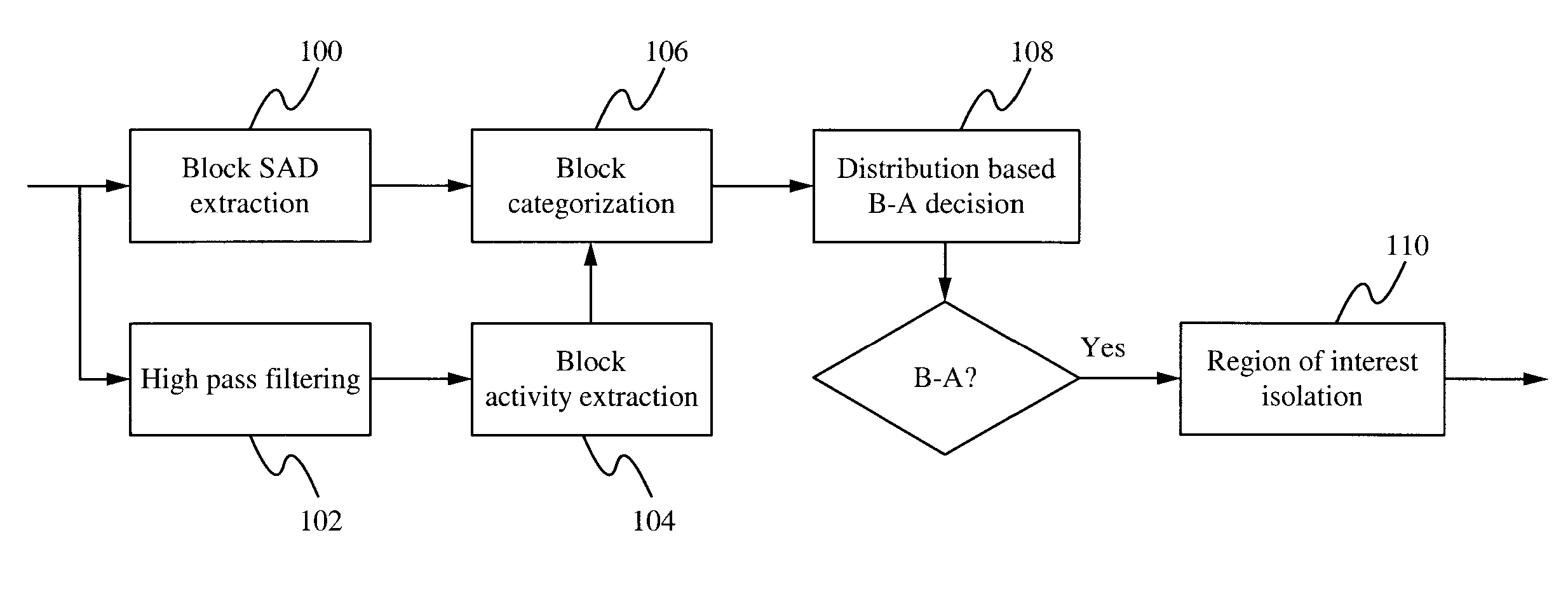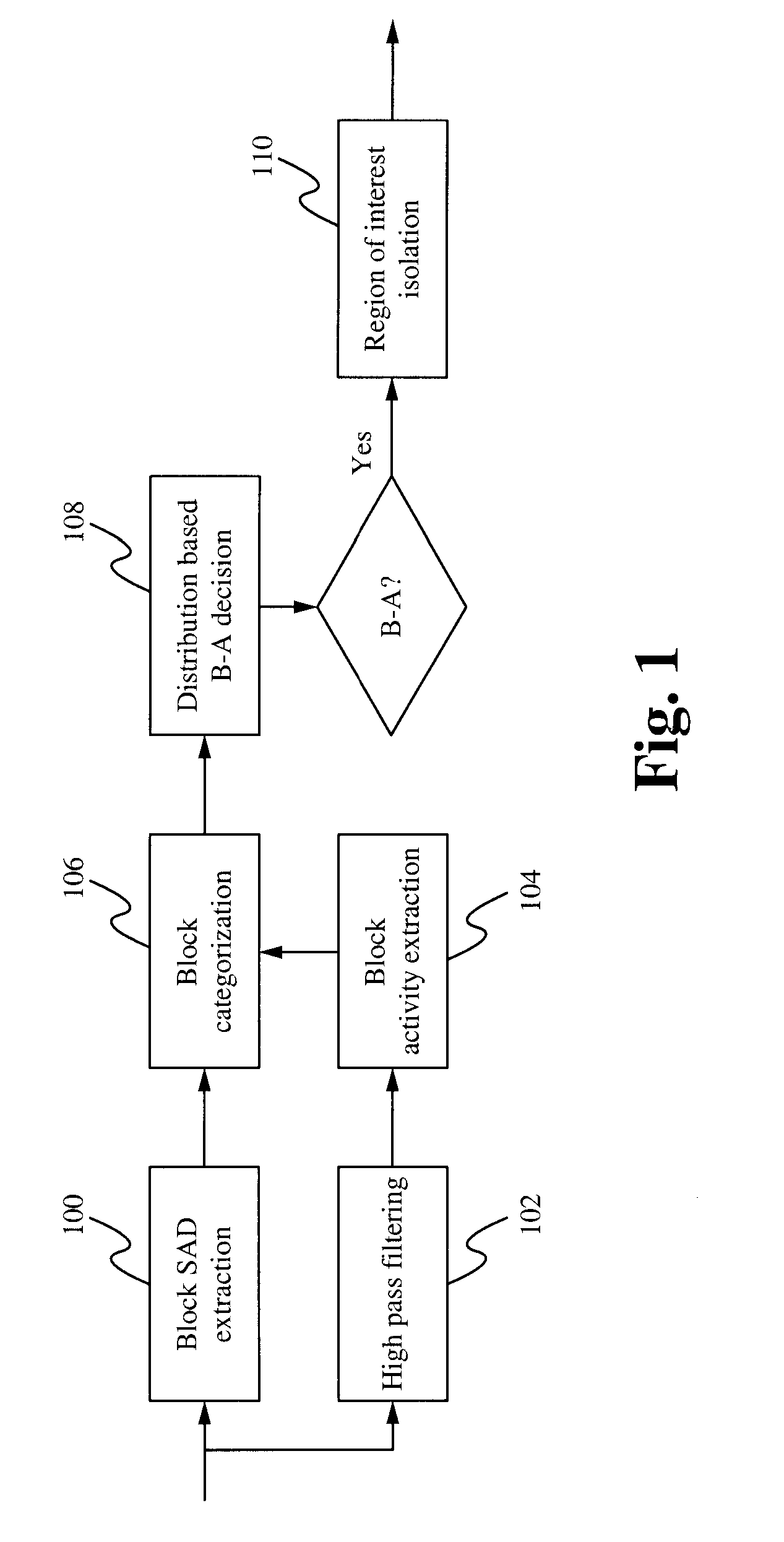[0004]A “Bokeh-Aji” image is one in which the region of interest is in focus and the background is out of focus. Detection of “Bokeh-Aji” type images and then isolation to the region of interest area in a low complexity way without any human intervention is beneficial. A set of tools for performing this task include SAD and high pass filtering based in-focus/out-of-focus area separation, in-focus/out-of-focus block distribution based “Bokeh-Aji” shot detection and region of interest isolation. By effectively integrating these tools together, the “Bokeh-Aji” images are successfully identified, and the region of interest area is successfully isolated.
[0005]In one aspect, a method implemented on a device comprises determining if an image includes an in-focus region of interest and an out-of-focus background using a processor and isolating the in-focus region of interest using the processor. Determining if the image includes the in-focus region of interest and the out-of-focus background further comprises calculating a Sum of Absolute Differences (SAD) of each block of an image, at the same time, high pass filtering the image to obtain a high pass filter image, calculating block activity for each block in the high pass filter image, attributing each block to one of three categories: an in-focus block, an out-of-focus block and a neutral block and deciding if the image includes the in-focus region of interest and the out-of-focus background based on the distribution of the three categories of blocks. Deciding if the image includes the in-focus region of interest and the out-of-focus background further comprises counting a first total amount of in-focus blocks, counting a second total amount of out-of-focus blocks, comparing the first total amount of the in-focus blocks to a first threshold, comparing the second total amount of the out-of focus blocks to a second threshold, comparing the first total amount of the in-focus blocks to a third threshold, if the first total amount of the in-focus blocks is greater than the first threshold, and if the second total amount of the out-of focus blocks is greater than the second threshold, and if the first total amount of the in-focus blocks is less than the third threshold, then the current image is detected as a Bokeh-Aji image. Isolating the in-focus region of interest further comprises extracting a location centroid of the in-focus region, calculating a mean value of a horizontal location and a vertical location of in-focus blocks, generating a center of an initial bounding box using one-third-rule based adjustment, generating a rectangle bounding box to contain the in-focus region, extracting an out-of-focus background, removing the out-of-focus background area within the bounding box and utilizing an adjusted bounding box area as the region of interest. Removing the out-of-focus background further comprises separating the bounding box into sub-boxes, counting the in-focus blocks within each sub-box of the sub-boxes, selecting candidate sub-boxes, denoting the sub-box as an interest sub-box for each row of sub-boxes, if the number of the in-focus blocks is larger or equal to 2, or if the number of the in-focus blocks is larger than 0 and one of the left neighbor sub-boxes has more than 2 in-focus blocks within; otherwise, the sub-box is denoted as a non-interest sub-box and generating a convex shape which is set as the region of interest by finding a leftmost interest sub-box and a rightmost interest sub-box for each row of sub-boxes, and denoting sub-boxes between the leftmost interest sub-box and the rightmost interest sub-box as interest sub-boxes, and finding the topmost interest sub-box and bottommost interest sub-box for each column of sub-boxes, and denoting the sub-boxes between the topmost interest sub-box and the bottommost interest sub-box as interest sub-boxes. The device is selected from the group consisting of a personal computer, a laptop computer, a computer workstation, a server, a mainframe computer, a handheld computer, a personal digital assistant, a cellular/mobile telephone, a smart appliance, a gaming console, a digital camera, a digital camcorder, a camera phone, an iPhone, an iPod®, a video player, a DVD writer/player, a television and a home entertainment system.
[0006]In another aspect, a method of isolating a region of interest implemented on a device comprises determining using a processor if an image includes an in-focus region of interest and an out-of-focus background further comprising calculating a Sum of Absolute Differences (SAD) of each block of an image, at the same time, high pass filtering the image to obtain a high pass filter image, calculating block activity for each block in the high pass filter image, attributing each block to one of three categories: an in-focus block, an out-of-focus block and a neutral block and deciding if the image includes the in-focus region of interest and the out-of-focus background based on the distribution of the three categories of blocks and isolating the in-focus region of interest using the processor. Deciding if the image includes the in-focus region of interest and the out-of-focus background further comprises counting a first total amount of in-focus blocks, counting a second total amount of out-of-focus blocks, comparing the first total amount of the in-focus blocks to a first threshold, comparing the second total amount of the out-of focus blocks to a second threshold, comparing the first total amount of the in-focus blocks to a third threshold, if the first total amount of the in-focus blocks is greater than the first threshold, and if the second total amount of the out-of focus blocks is greater than the second threshold, and if the first total amount of the in-focus blocks is less than the third threshold, then the current image is detected as a Bokeh-Aji image. Isolating the in-focus region of interest further comprises extracting a location centroid of the in-focus region, calculating a mean value of a horizontal location and a vertical location of in-focus blocks, generating a center of an initial bounding box using one-third-rule based adjustment, generating a rectangle bounding box to contain the in-focus region, extracting an out-of-focus background, removing the out-of-focus background area within the bounding box and utilizing an adjusted bounding box area as the region of interest. Removing the out-of-focus background further comprises separating the bounding box into sub-boxes, counting the in-focus blocks within each sub-box of the sub-boxes, selecting candidate sub-boxes, denoting the sub-box as an interest sub-box for each row of sub-boxes, if the number of the in-focus blocks is larger or equal to 2, or if the number of the in-focus blocks is larger than 0 and one of the left neighbor sub-boxes has more than 2 in-focus blocks within; otherwise, the sub-box is denoted as a non-interest sub-box and generating a convex shape which is set as the region of interest by finding a leftmost interest sub-box and a rightmost interest sub-box for each row of sub-boxes, and denoting sub-boxes between the leftmost interest sub-box and the rightmost interest sub-box as interest sub-boxes, and finding the topmost interest sub-box and bottommost interest sub-box for each column of sub-boxes, and denoting the sub-boxes between the topmost int...
 Login to View More
Login to View More  Login to View More
Login to View More 


